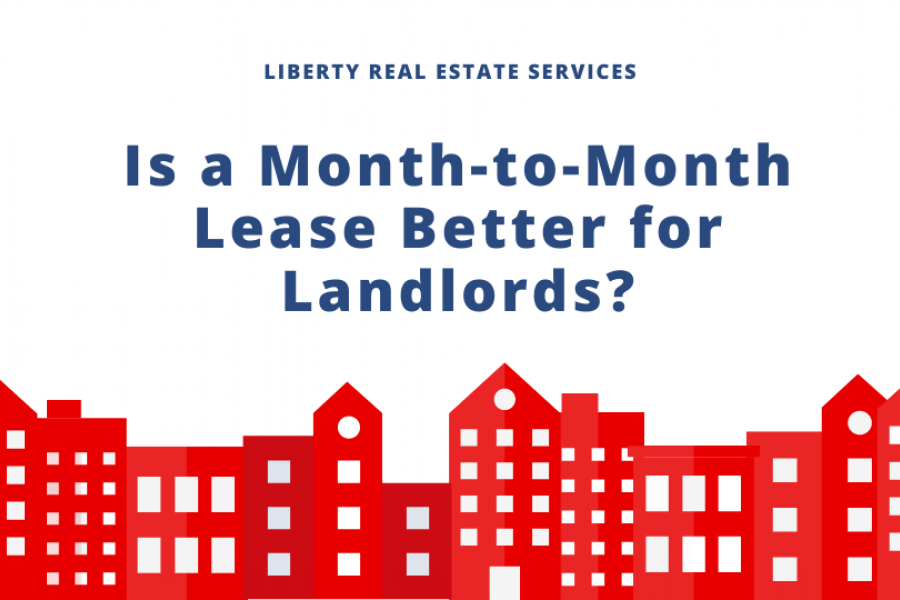
New landlords often have to decide whether to rent out their properties for a longer period or on a short-term basis. Short-term leases have less than a year of rental duration, whereas traditional or long-term leases cover a year or two of the rental period.
Before making up your mind, you need to consider what rental term suits your property. This guide by Liberty Real Estate Services will discuss the advantages and disadvantages of month-to-month leases, helping you decide when you should choose them.
What Is a Month-to-Month Lease?
When talking about month-to-month leases, this refers to the contract between a landlord and tenant that renews automatically every month. Should either party wish to end the agreement, a 30-day notice must be submitted to express the intent to terminate the month-to-month lease.
Initially, after a long-term lease ends, a renter may want to extend the agreement and the landlord may allow the extension of the contract monthly. This is regarded as a month-to-month lease. It is also possible that both parties started a month-to-month lease for various reasons.
Month-to-Month Lease Arrangement
In general, a month-to-month lease offers more flexibility, especially for landlords looking to sell their properties soon or waiting for the economic conditions to improve so the real estate prices will increase.
.jpg)
As soon as a buyer appears or the state of the economy takes a positive turn, it will be simple to end the leasing agreement.
The Advantages of Month-to-Month Leases
The end-date flexibility
Unlike with traditional leases where you have to wait out the end of the rental term, month-to-month leases can be terminated) after giving a 30-day notice. So, if there are any new situations, such as a buyer when you want to sell your rental property, it is hassle-free to end the rental arrangement.
You may want to convert your rental place into your place of residence or office, so having a month-to-month lease means you can make the switch easily.
If you are a new landlord, try a short-term leasing term to see if it is more suitable. While you are refining your rental processes, a month-to-month lease can provide you with more flexibility.
Ability to quickly raise the rental rate.
Unlike a traditional lease where it can be difficult to adjust the set rental rate, a month-to-month lease allows you to change your rental prices easily, in response to market demand. As a landlord, you can earn better when you adjust to the seasonal demand.
If you have a vacation home then you can increase the rate during the summer season, when more tourists flock to your area. You can also reduce the rate during the off-peak season to remain competitive and continue attracting renters.
.jpg)
Avoid dealing with penalties after the tenancy ends
As long as you send a 30-day notice to the renter, you will not have to face any penalties when they end a month-to-month lease. Since the renter already knows the temporary arrangement of month-to-month leases, they are aware and prepared that the tenancy can expire within a month.
Choose high-quality residents
Unlike a traditional lease where you have to follow eviction procedures that can take a lot of time, a month-to-month lease makes it easy to remove renters who don’t pay the rent on time or take care of your rental well.
The Disadvantages of a Month-to-Month Lease Arrangement
Uncertainty of end dates
Flexibility can also translate to uncertainty. Since month-to-month leases are temporary, you cannot expect things to be unchanging. You may have top-tier renters that contribute to stable earnings and take care of your property properly, but you cannot expect them to stay longer, compared to having them sign a long-term lease.
Little notice to search for new residents
Having only thirty days to look for new renters can be a short period. It can place a lot of pressure on landlords, which can end up pushing them to accept renters quickly without proper screening to avoid a vacancy.
Inconsistent rental income
With leases that have a long-term duration, you can expect to receive a monthly income for a year or two. However, with month-to-month leases, you are subject to the occupancy of your rental space.

During peak season, your vacation home may provide you with a stable income, while during off-peak season, the occupancy rate will be low. A series of vacancies can reduce your income.
Signing a Month-to-Month Lease
As a landlord, you should make sure to have a written lease even if you choose a month-to-month leasing arrangement. You can avoid signing a new lease every month’s end by stipulating a holding-over clause in your contract.
The Holding Over clause will state that the leasing arrangement will be honored monthly after the lease expires.
What Is the 30 Day-Notice for a Month-to-Month Lease?
A 30-day notice is sent in advance to alert the other party that you wish to end the month-to-month lease. This prevents conflicts between you and your tenant, fostering positive landlord-tenant relations.
The notice period will give landlords time to update policies and adjust the rental rates. If the rental price will be increased, then landlords must provide a written notice.
In fact, in some states, landlords are required to send the notice using certified mail. It is best to check out your state laws to ensure you are compliant.
Bottom line
Now that you know the benefits and drawbacks that come with month-to-month leases, you can decide which fits your needs. It is recommended to hire a property manager when you opt for a month-to-month leasing arrangement since you will need to often screen renters, market the unit, and maintain it well.
If you’re looking for one, contact Liberty Real Estate Services today and learn more about our services!
